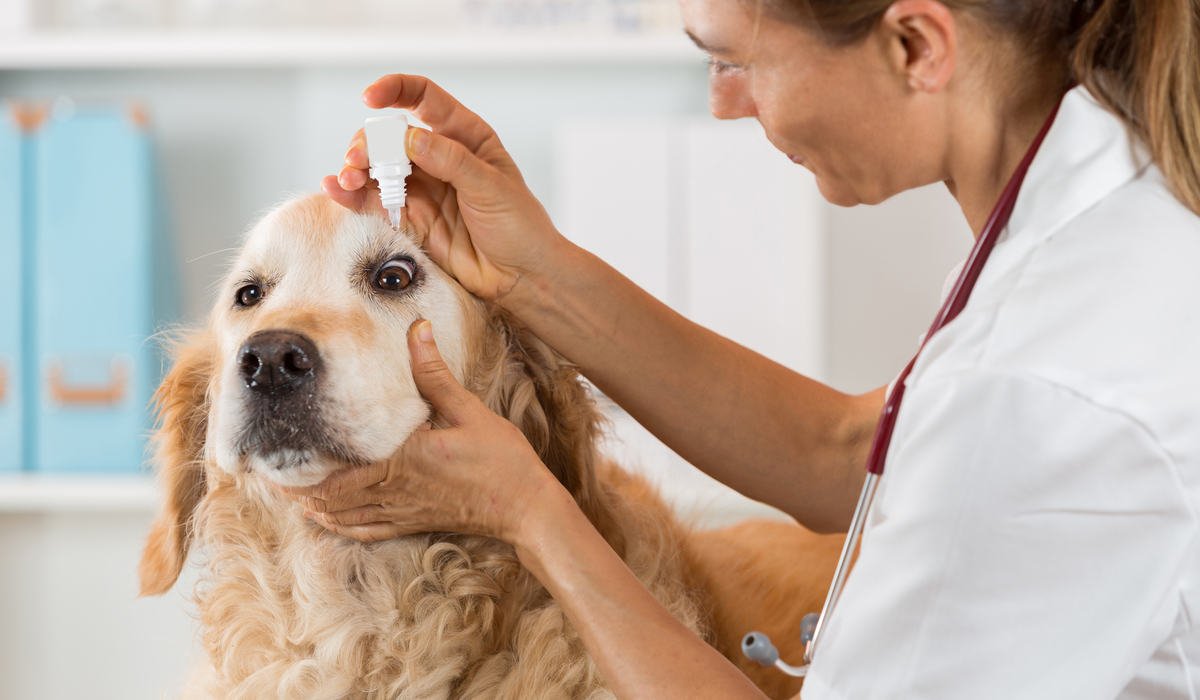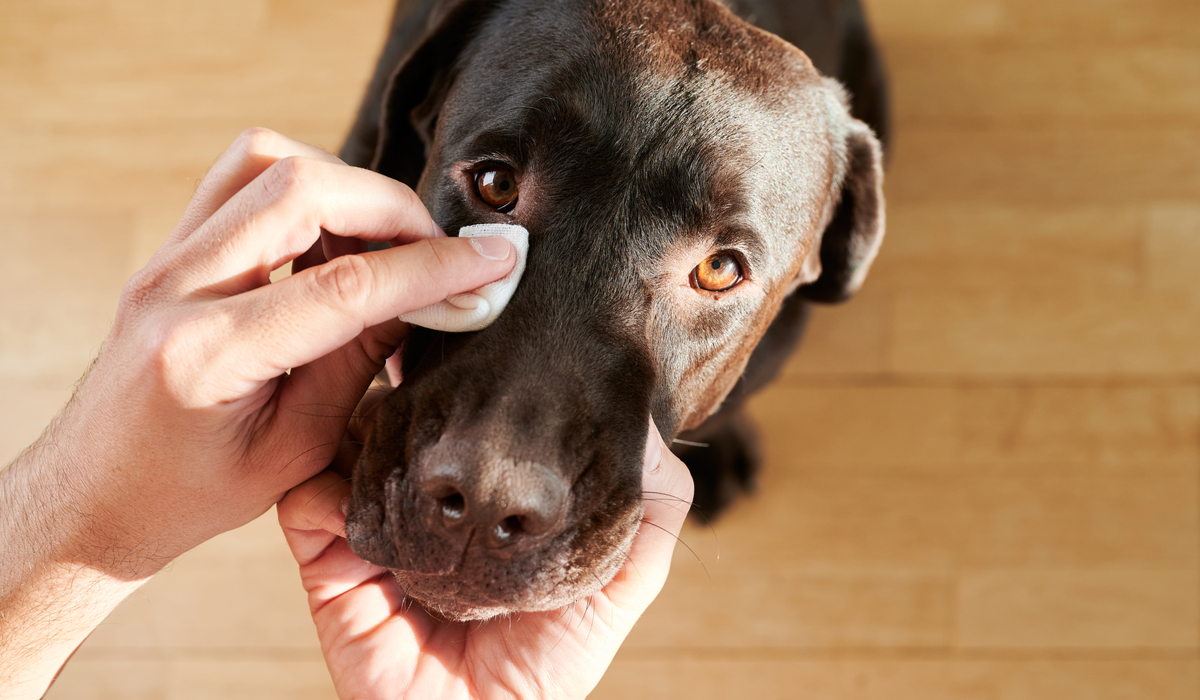Dog eye boogers. There’s your normal, everyday eye boogers — the dryish ones that show up in the morning or after a nap — then there are kinds that indicate an eye infection.
The more civilized term you’ll hear your veterinarian say is “eye discharge,” of course. All dogs experience it for one reason or another. While common, sometimes types of eye discharge require a vet’s diagnosis.
Common Causes of Eye Discharge in Dogs

What does it mean when a dog’s eye gunk is crusty?
What about tear stains?
Why is it green?
We will answer these questions and more as we break down what your dog’s eye boogs are all about, as well as when to be concerned.
Eye Infection
Dogs get pink eye, too! Doggie pink eye, otherwise known as conjunctivitis, occurs for a variety of reasons. DVM Amy Flowers of WebMD says that in order to determine how to treat it, you need to learn what’s causing it first.
Common causes of conjunctivitis include birth defects, blocked tear ducts, allergies, or a foreign body in the eyelid.
Signs your dog has an eye infection like conjunctivitis include yellow-green pus coming out the tear ducts and watery eyes. Pus-like green discharge is never good.
If your dog exhibits the following behaviors, it might have an eye problem:
- Constant linking
- Squinting often
- Pawing at the eyes
- Keeping eyes closed
Depending on the cause, treatment for this kind of eye infection can include an antibiotic eye ointment, removing the irritant, and saline eyewashes or warm compresses. In severe cases, surgery may be required for such eye issues.
Dry eye

Dogs can get dry eye just like humans do. Medically termed Keratoconjunctivitis sicca (KCS), it means the cornea is inflamed due to dry surrounding tissues.
VCA Animal Hospitals explains: “Any condition that impairs the ability to produce adequate amounts of tear film can result in dry eye.”
Eyes need to be lubricated. That’s where your dog’s tears come in. Your dog’s eye health can be seriously affected if there isn’t enough tear film to lubricate the eyes and remove foreign bodies and irritants via tear glands.
Some common causes of KCS listed by DVMs Tammy Hunter and Ernest Ward of VCA include:
- Hypothyroidism
- An inherited immune disorder
- Systemic diseases like distemper
- Certain medications
Certain dog breeds are more prone to KCS than others. Pugs, bulldogs, poodles, Cocker spaniels, bloodhounds, and Boston terriers are a few breeds that commonly develop dry eye.
Dry eye treatment
Your vet may give you eye drop medications or artificial tears that are designed to stimulate tear production in order to protect the cornea. Depending on your dog’s condition, they may need to receive eye drops more than once a day. In combination with the eye drops, carefully cleaning the eyes with a wet washcloth soaked in warm water may bring relief.
Epiphora

Epiphora, or excessive tearing, is the opposite of dry eye. Excess fluid comes out of the inner corner of your dog’s eyes, wetting the fur on your dog’s face.
A vet will perform a thorough examination of your dog’s eyes in order to determine the cause of its ocular discharge. According to DVMs at VCA Animal Hospitals, common causes of epiphora include:
- Conjunctivitis
- Allergies
- Eye injuries
- Eyelash abnormalities
- Corneal ulcers
- Glaucoma
Treatment may include a surgical procedure, but it really depends on the underlying cause. Talk to a veterinarian as soon as possible if you think your pooch may have epiphora.
Corneal ulcers
A corneal ulcer is a sore or wound on the eye’s corneal surface due to trauma. Trauma to the eye can be caused by anything from rough play with other dogs to an irritating substance or debris. Corneal ulcers are common in dogs with dry eye or dogs that are brachycephalic.
Corneal ulcers are painful. If you notice any of these symptoms, take your dog to the vet right away:
- Pawing at the eyes
- Squinting
- Excessive discharge
- Red eyes
CVT Nancy Thompson of Ethos Veterinary Health says that simple ulcers can clear up on their own (along with eye drops or antibiotic ointments to prevent infection) within 3-10 days. Deep corneal ulcers may require eye drop administration several times a day. In severe cases, corneal surgery may be required.
A sleepy dog’s eye discharge

Then again, your dog’s eye boogers may simply be the little eye crusts you get after waking from a good night’s rest or nap. This kind of discharge should be clear and turns a little brown when dried. Just watch out for excessive buildup and gently wipe off with a cotton ball.
Eye-deas for Preventing Eye Problems

While that heading is admittedly cornea, give your vet a call if you notice any of the symptoms listed above. To prevent future eye problems and maintain good eye health, the Michigan State University’s College of Veterinary Medicine recommends the following:
- Avoid using irritating soaps or sprays near your pet’s eyes
- Gently wipe discharge or mucus out of your pet’s eyes using a clean, damp cotton ball (use a different cotton ball for each eye)
- If you have a dog with long hair, keep it trimmed around their eyes
- Make sure they have access to natural light
- If your pet is outdoors a lot, make sure it has access to shelter and shade
- A balanced diet that includes antioxidants that support eye health
Another important prevention method of note is to not let your dog stick its head out of the window during car rides. “The wind can dry its eyes out, leading to irritation. Debris and insects may also fly into their eyes, causing pain and injury,” warns Michigan State vets.
Dog Eye Boogers
Don’t forget to get your dog routine eye exams during their annual checkups. Eye health is an important factor for your dog’s overall health and wellbeing. With the right precautions and care, your dog’s eyes will be a vision to behold!

